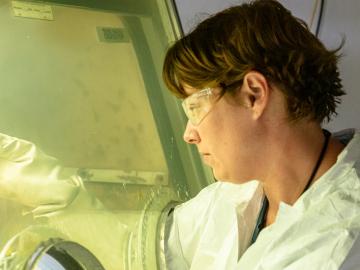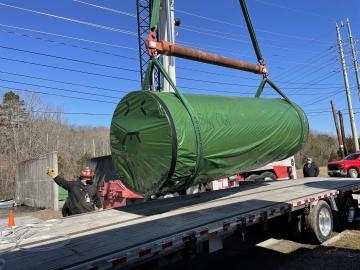
Filter News
Area of Research
- (-) Fusion and Fission (32)
- (-) Isotopes (21)
- Advanced Manufacturing (5)
- Biological Systems (1)
- Biology and Environment (102)
- Biology and Soft Matter (4)
- Building Technologies (2)
- Chemical and Engineering Materials (3)
- Chemistry and Physics at Interfaces (7)
- Clean Energy (168)
- Climate and Environmental Systems (7)
- Computational Biology (1)
- Computational Chemistry (5)
- Computational Engineering (1)
- Computer Science (3)
- Data (1)
- Earth Sciences (1)
- Electricity and Smart Grid (1)
- Energy Frontier Research Centers (7)
- Fuel Cycle Science and Technology (2)
- Functional Materials for Energy (8)
- Fusion Energy (7)
- Geographic Information Science and Technology (1)
- Materials (122)
- Materials for Computing (13)
- Materials Synthesis from Atoms to Systems (8)
- Materials Under Extremes (7)
- National Security (45)
- Neutron Data Analysis and Visualization (2)
- Neutron Science (72)
- Nuclear Science and Technology (27)
- Quantum Condensed Matter (3)
- Quantum information Science (4)
- Renewable Energy (2)
- Sensors and Controls (2)
- Supercomputing (153)
- Transportation Systems (4)
News Topics
- 3-D Printing/Advanced Manufacturing (3)
- Advanced Reactors (2)
- Artificial Intelligence (1)
- Bioenergy (1)
- Biomedical (3)
- Buildings (1)
- Chemical Sciences (2)
- Composites (1)
- Computer Science (1)
- Decarbonization (1)
- Energy Storage (2)
- Environment (2)
- Exascale Computing (1)
- Frontier (1)
- Fusion (12)
- Grid (1)
- High-Performance Computing (2)
- Isotopes (15)
- ITER (2)
- Materials (2)
- Materials Science (1)
- National Security (1)
- Net Zero (1)
- Nuclear Energy (19)
- Partnerships (1)
- Physics (1)
- Security (1)
- Simulation (2)
- Space Exploration (2)
- Sustainable Energy (3)
- Transportation (1)
Media Contacts

To achieve practical energy from fusion, extreme heat from the fusion system “blanket” component must be extracted safely and efficiently. ORNL fusion experts are exploring how tiny 3D-printed obstacles placed inside the narrow pipes of a custom-made cooling system could be a solution for removing heat from the blanket.

ORNL manages the Innovation Network for Fusion Energy Program, or INFUSE, with Princeton Plasma Physics Laboratory, to help the private sector find solutions to technical challenges that need to be resolved to make practical fusion energy a reality.

It’s elemental — scientists agree that the periodic table is incomplete. And when it comes to unveiling parts of the periodic table yet undiscovered, ORNL is doing some heavy lifting.

A 25-year career with the U.S. Navy, commanding combat missions overseas, brought Tom Kollie back to where he came from — ready to serve his country in a new way.

As a medical isotope, thorium-228 has a lot of potential — and Oak Ridge National Laboratory produces a lot.

The receipt of a nuclear fuel canister is boosting the research of an Oak Ridge National Laboratory team investigating methods to help the nation effectively dispose of nuclear waste for the long term.

Four first-of-a-kind 3D-printed fuel assembly brackets, produced at the Department of Energy’s Manufacturing Demonstration Facility at Oak Ridge National Laboratory, have been installed and are now under routine operating

In the mid-1980s, Balendra Sutharshan moved to Canada from the island nation of Sri Lanka. That move set Sutharshan on a path that had him heading continent-spanning collaborations and holding leadership posts at multiple Department of Energy

Oak Ridge National Laboratory expertise in fission and fusion has come together to form a new collaboration, the Fusion Energy Reactor Models Integrator, or FERMI

For years Brenda Smith found fulfillment working with nuclear batteries, a topic she’s been researching as a chemist at Oak Ridge National Laboratory.


